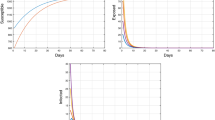Abstract
Analytical methods for predicting and exploring the dynamics of stochastic, spatially interacting populations have proven to have useful application in epidemiology and ecology. An important development has been the increasing interest in spatially explicit models, which require more advanced analytical techniques than the usual mean-field or mass-action approaches. The general principle is the derivation of differential equations describing the evolution of the expected population size and other statistics. As a result of spatial interactions no closed set of equations is obtained. Nevertheless, approximate solutions are possible using closure relations for truncation. Here we review and report recent progress on closure approximations applicable to lattice models with nearest-neighbour interactions, including cluster approximations and elaborations on the pair (or pairwise) approximation. This study is made in the context of an SIS model for plant-disease epidemics introduced in Filipe and Gibson (1998, Studying and approximating spatio-temporal models for epidemic spread and control, Phil. Trans. R. Soc. Lond. B 353, 2153–2162) of which the contact process [Harris, T. E. (1974), Contact interactions on a lattice, Ann. Prob. 2, 969] is a special case. The various methods of approximation are derived and explained and their predictions are compared and tested against simulation. The merits and limitations of the various approximations are discussed. A hybrid pairwise approximation is shown to provide the best predictions of transient and long-term, stationary behaviour over the whole parameter range of the model.
Similar content being viewed by others
References
ben Avraham, D. and J. Kohler (1992). Mean-field (N,M)-cluster approximation for lattice models. Phys. Rev. A 45, 8358–8370.
Bethe, H. A. (1935). Statistical theory of superlattices. Proc. R. Soc. A 150, 552–575.
Buttell, L., J. T. Cox and R. Durrett (1993). Estimating the critical values of stochastic growth models. J. Appl. Probab. 30, 455–461.
Cardy, J. L. and R. L. Sugar (1980). Directed percolation and Reggeon field theory. J. Phys. A 13, L423.
Ellner, S. P., A. Sasaki, Y. Haraguchi and H. Matsuda (1998). Speed of invasion in population models: pair-edge approximation. J. Math. Biol. 36, 469–484.
Filipe, J. A. N. (1999). Hybrid closure-approximation to epidemic models. Physica A 266, 238–241.
Filipe, J. A. N. and G. J. Gibson (1998). Studying and approximating spatio-temporal models for epidemic spread and control. Phil. Trans. R. Soc. Lond. B 353, 2153–2162.
Filipe, J. A. N. and M. M. Maule (2001). Effects of dispersal mechanisms on spatio-temporal development of epidemics, submitted.
Filipe, J. A. N. and G. J. Rodgers (1995). Theoretical and numerical studies of chemisorption on a line with precursor layer diffusion. Phys. Rev. E 52, 6044–6054.
Gibson, G. J. (1997a). Investigating mechanisms of spatio-temporal epidemic spread using stochastic models. Phytopathology 87, 139–146.
Gibson, G. J. (1997b). Markov chain Monte Carlo methods for fitting spatiotemporal stochastic models in plant epidemiology. Appl. Stat. C 46, 215–233.
Gottwald, T. R., G. J. Gibson, S. M. Garnsey and M. Irey (1999). Examination of the effect of aphid vector population composition on the spatial dynamics of citrus tristeza virus spread via stochastic modelling. Phytopathology 89, 603–608.
Harris, T. E. (1974). Contact interactions on a lattice. Ann. Prob. 2, 969.
Hiebeler, D. (1997). Stochastic spatial models: from simulations to Mean Field and local structure approximations. J. Theor. Biol. 187, 307–319.
Jeger, M. J. (1986). The potential of analytic compared with simulation approaches to modelling in plant disease epidemiology, in Plant Disease Epidemiology. Vol. 1: Population Dynamics and Management, K. J. Leonard and W. E. Fry (Eds), New York: Macmillan.
Jeger, M. J. (Ed.) (1989). Spatial Components of Plant Disease Epidemics, Englewood Cliffs, NJ: Prentice Hall.
Jeger, M. J. and M. S. Chan (1995). Theoretical aspects of epidemics—uses of analytical models to make strategic management decisions. Can. J. Plant Pathol. 17, 109–114.
Jeger, M. J. and F. van den Bosch (1994). Threshold criteria for model-plant disease epidemics. 1 Asymptotic results. Phytopathology 84, 24–27.
Jeger, M. J., F. van den Bosch, L. V. Madden and J. Holt (1998). A model for analysing plant-virus transmission characteristics and epidemic development. IMA J. Math. Appl. Med. Biol. 15, 1–18.
Keeling, M. J., D. A. Rand and A. J. Morris (1997). Correlation models for childhood epidemics. Proc. R. Soc. Lond. B 264, 1149–1156.
Kikuchi, R. (1951). Theory of cooperative phenomena. Phys. Rev. 81, 988–1003.
Kramers, H. A. and G. H. Wannier (1941). Statistics of the two-dimensional ferromagnet. Phys. Rev. 60, 252–263.
Levin, S. A. and R. Durrett (1997). From individuals to epidemics. Phil. Trans. R. Soc. Lond. B 351, 1615–1621.
Liggett, T. M. (1999). Stochastic Interacting Systems, New York: Springer.
Matsuda, H., N. Ogita, A. Sasaki and K. Sato (1992). Statistical mechanics of population—the lattice Lotka-Volterra model. Prog. Theor. Phys. 88, 1035–1049.
Maule, M. M. and J. A. N. Filipe (2001). Modelling epidemics with anisotropic spread (in preparation).
Mollison, D. (Ed.) (1994). Epidemic Models and their Relation to Data, Cambridge: Cambridge University Press.
Sato, K., H. Matsuda and A. Sasaki (1994). Pathogen invasion and host extinction in lattice structured populations. J. Math. Biol. 32, 251–268.
Stanley, E. H. (1972). Introduction to Phase Transitions and Critical Phenomena, U.S.A.: Oxford University Press, Inc.
Author information
Authors and Affiliations
Corresponding author
Rights and permissions
About this article
Cite this article
Filipe, J.A.N., Gibson, G.J. Comparing approximations to spatio-temporal models for epidemics with local spread. Bull. Math. Biol. 63, 603–624 (2001). https://doi.org/10.1006/bulm.2001.0234
Received:
Accepted:
Issue Date:
DOI: https://doi.org/10.1006/bulm.2001.0234




